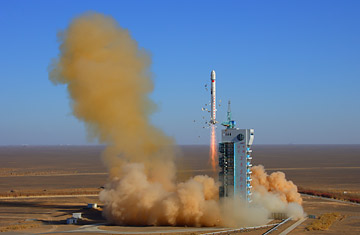
A Chinese satellite is launched in 2008
The earth's surface moves faster at the equator, which is why it's such a good place to launch a rocket. The extra spin gives a small boost to the massive machines as they power into space, and allows the rockets to carry heavier payloads. That's one reason China is expanding its Wenchang launch center on Hainan Island, a land of palm trees, white beaches and nuclear submarines snuggled in tight against China's southern coast just 19 degrees north of the equator. Beijing hopes the base, which will open in 2013, will help China join the big Western players in the commercial satellite-launch business.
Not that it needs much help. Since 2002 China has sent 15 commercial satellites into orbit, including last October's launch of a communications satellite for Venezuela. Beijing says it plans to launch an additional 15 commercial satellites this year. Last month, it reportedly signed a contract with European communications company Eutelsat to launch a five-ton satellite in 2010. The deal, which industry experts expect to be officially announced at a satellite convention in Washington, D.C. later this month, will be Beijing's first with a Western satellite operator since 1998, when the U.S. sharply restricted the technologies American companies could sell or even send to China. (See pictures of the Earth from space.)
That ban initially hurt China's commercial-launch business but in the long run it could end up helping Beijing. Designed to prevent China from getting hold of U.S.-made technology that could be used in military applications, the restrictions apply to exports such as weapons and certain commercial machinery. Because most commercial satellite builders have traditionally relied on U.S. parts, the legislation also effectively barred firms in Europe and elsewhere from using China to launch their products.
That's why the Eutelsat agreement is such a big deal. If confirmed, it would not only mark a business coup for China, but signal a major blow to Washington's technology ban. Several European aerospace groups including France's Thales, Italy's Finmeccanica and pan-European consortium EADS have been working on how to build satellites and components free of U.S. content. Over the past decade, meantime, China has perfected relatively cheap launches for companies and governments from Asia, Africa and South America.
Put those two facts together and China is well placed to grab more of the global launch market. "The restrictions have placed China outside the commercial- launch sector dominated by American, European and Russian companies — meaning China has to offer services at far lower prices if it wants to become a major player," says Jeff Foust, senior analyst at U.S. aerospace and telecommunications consulting firm Futron. "China has that ambition."
It's still early days. Some 25 Western-built commercial satellites are sold world-wide each year, but only six have been built since 2002 without the American components restricted by the International Traffic in Arms Regulations (ITAR), as Washington's controls are known. "That's less than 5% of total sales over the past six years, and it does not constitute the threat to U.S. satellite companies that some are claiming," notes one industry source, who did not wish to be named.
